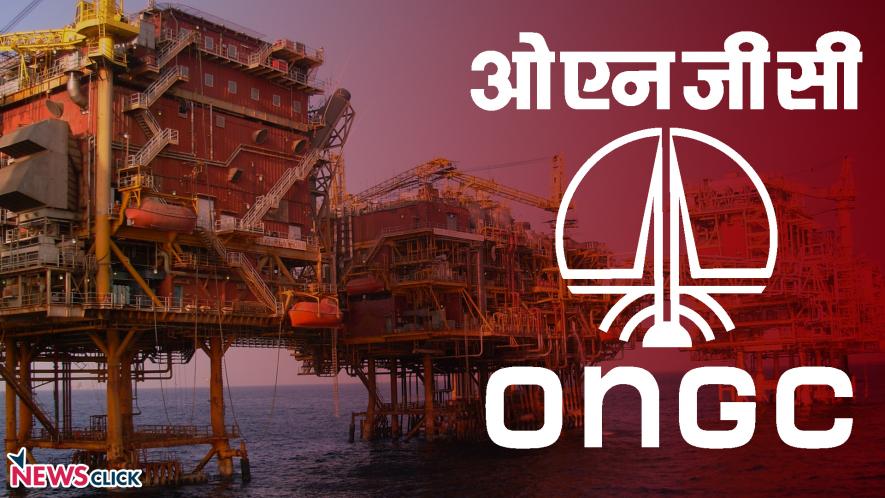ONGC: From Cash Cow to Sacrificial Lamb?

The BJP-led government at the Centre is set to ask the Oil and Natural Gas Corporation (ONGC) to bear a fuel subsidy to bring down the retail prices of petrol and diesel. The move, however, should not be seen as a one-off incident and is in fact part of a series of measures by this government that have hurt the profitability of ONGC - a ‘Maharatna’ and one of India’s most profitable PSUs.
The fuel subsidy is a burden imposed on the upstream of the petroleum industry - those who explore and produce the crude oil - to enable the downstream - the oil marketing companies (OMCs) - to sell fuel to consumers at a lower price. While this practice is nothing new, the recent decision has come at a time when ONGC chairman Shashi Shanker has reportedly said that the PSU was “already in the red.”
Last August, ONGC acquired the entire 80% stake of the Gujarat State Petroleum Corporation in a Krishna Godavarari (KG) basin gas block in the Bay of Bengal for Rs.7,783 crore. This was a highly questionable deal as the GSPC’s discovery, which was made in 2005, had not resulted in any commercial production by late 2015, even with an investment of Rs.19,576 crore.
In a letter to the Securities Exchange Board of India (SEBI) Chairman U K Sinha, Rajya Sabha MP Jairam Ramesh noted that “GSPC has spent large sums of money, hired foreign experts and imported sophisticated equipment and yet could not find gas. Then, why does ONGC deem it fit to pay ₹8,000 crores to acquire this very block?” Considering the fact that the GSPC was earlier a showpiece of Prime Minister Narendra Modi’s Gujarat model, the questions arises if pressure from the Centre led to the move.
Then came ONGC’s acquisition of the central government’s 51.11 per cent equity in Hindustan Petroleum Corporation Limited (HPCL) earlier this year. The ONGC - HPCL deal happened at a time when the government was faltering in its goal of keeping the fiscal deficit within its target of 3.2% of the Gross Domestic Product (GDP) - thanks to below-expected levels of GST collections and non-tax revenues. At the same time, the government had also not met its “disinvestment target” of collecting Rs. 72,500 crore in that financial year. Thus, through an act of statistical jugglery - by making one PSU buy out the its equity in another PSU - the government in effect killed two birds with one stone. It managed its fiscal deficit level and also managed to “disinvest” enough.
But what was the impact of this acquisition on ONGC? It had to borrow a whopping Rs. 35,000 crores from banks to finance the deal. The banks which lent the money were: Punjab National Bank (Rs.10,600 crore for one year), Bank of India (Rs.4,460 crore for one year), AxisBank (Rs.3,000 crore for one year), SBI (Rs.7,340 crore), HDFC and ICICI (Rs.4,000 crore each for a year), Export-Import Bank of India (Rs.1600 Crore for one year). The deals and the ensuing borrowing are certainly likely to have contributed to ONGC being “in the red.”
It is important to note that ONGC, besides being an oil producer, is also involved in exploration. The business of exploration requires heavy investment of capital, often for long periods. One can only wonder how a corporation “in the red” will be able to carry out this work.
ONGC is also involved in operations abroad through its arm ONGC Videsh Limited (OVL). OVL currently has a stake in 41 oil and gas projects in 20 countries. Even with such a huge multinational profile, ONGC does not figure on the oft-referenced Fortune 500 list while Chinese state companies Sinopec Group and China National Petroleum sit third and fourth respectively on the same list. For a government which often indulges in the rhetoric of competing with the Chinese economically, this fact should be damning.
In the light of this, the move to make ONGC bear a fuel subsidy can only lead to a decline in the corporation's profitability. Tapan Sen, general secretary of Centre of Indian Trade Unions, when contacted by Newsclick, said, “It is the political responsibility of the government to cut fuel prices but they are putting this responsibility on ONGC.” On how the burden of the acquisitions and subsidy may affect the corporation, he said “These may reduce the investing capacity of the company and can also hamper its ability to progress technologically.” He also pointed to the example of Air India, whose profitability was slowly eroded and is now in the process of being sold off. He called it the government’s “gameplan to sell the public sector cheaply.” ONGC being in rough waters is undoubtedly likely to benefit the private players in the oil exploration business, including Reliance Industries Limited.
The government has clearly used ONGC as a cash cow to fund acquisitions to fill its coffers and meet its targets, and is now using it as a sacrificial lamb to bear the subsidy burden. In this process, one of the country’s most valuable PSUs faces the risk of a slow decline, which may lead to calls for disinvestment. Yet again, the government seems encouraging a cycle whereby it hurts the profitability of PSUs and then uses that as a pretext for selling it off.
Get the latest reports & analysis with people's perspective on Protests, movements & deep analytical videos, discussions of the current affairs in your Telegram app. Subscribe to NewsClick's Telegram channel & get Real-Time updates on stories, as they get published on our website.
























